Buddhism and Judaism Quiz: World Religions GHUM 1143 Exam Prep
VerifiedAdded on 2023/06/10
|8
|1462
|199
Quiz and Exam
AI Summary
This is a quiz for the World Religions course (GHUM 1143) that tests knowledge of Buddhism and Judaism. The Buddhism section covers topics like Dhyana/Jhana, the Dalai Lama, Vajrayana Buddhism, the six perfections (prajna), almsgiving (dana), Buddhist monks (Bhikshus) and nuns (Bhiksuni), mudras, Zen Buddhism sects (Rinzai and Soto), the Fundamentals of Dharma (Dhamma/Dhammapada), Jataka stories, the term Arhant, Dr. Bhimrao R. Ambedkar's role in reviving Buddhism in India, the Temple of the Tooth in Sri Lanka, Padmasambhava, Bodhisattvas, the Eightfold Path, Shakyamuni, Zazen, Mandalas, and the Triple Gem. The Judaism section includes questions on the definition of Israel, Mishnah interpretations (halakha and haggadah/aggadah), Tsaddik, the First Temple of Jerusalem (King Solomon), the Pentateuch, the revolt against Roman occupation (Shimon bar Kosiba), Kashrut, Mitzvah, Isaac Luria, Maimonides, Responsa, Minyan, Adonai, Theodor Herzel and Zionism, Haredim, Pharisees, Tanakh, Babylonian Talmud, The Zohar, and the Pentateuch. Desklib provides access to similar past papers and solved assignments.
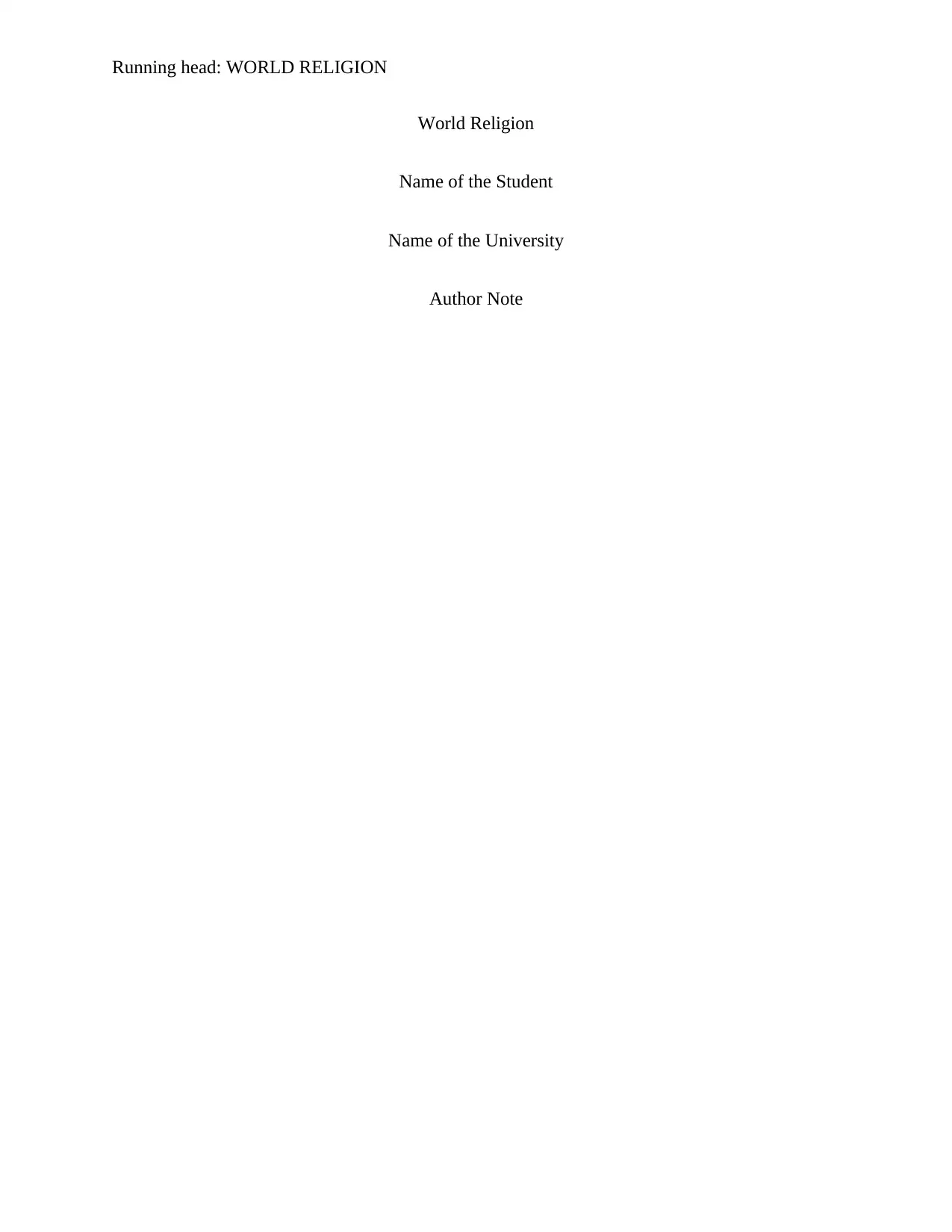
Running head: WORLD RELIGION
World Religion
Name of the Student
Name of the University
Author Note
World Religion
Name of the Student
Name of the University
Author Note
Paraphrase This Document
Need a fresh take? Get an instant paraphrase of this document with our AI Paraphraser
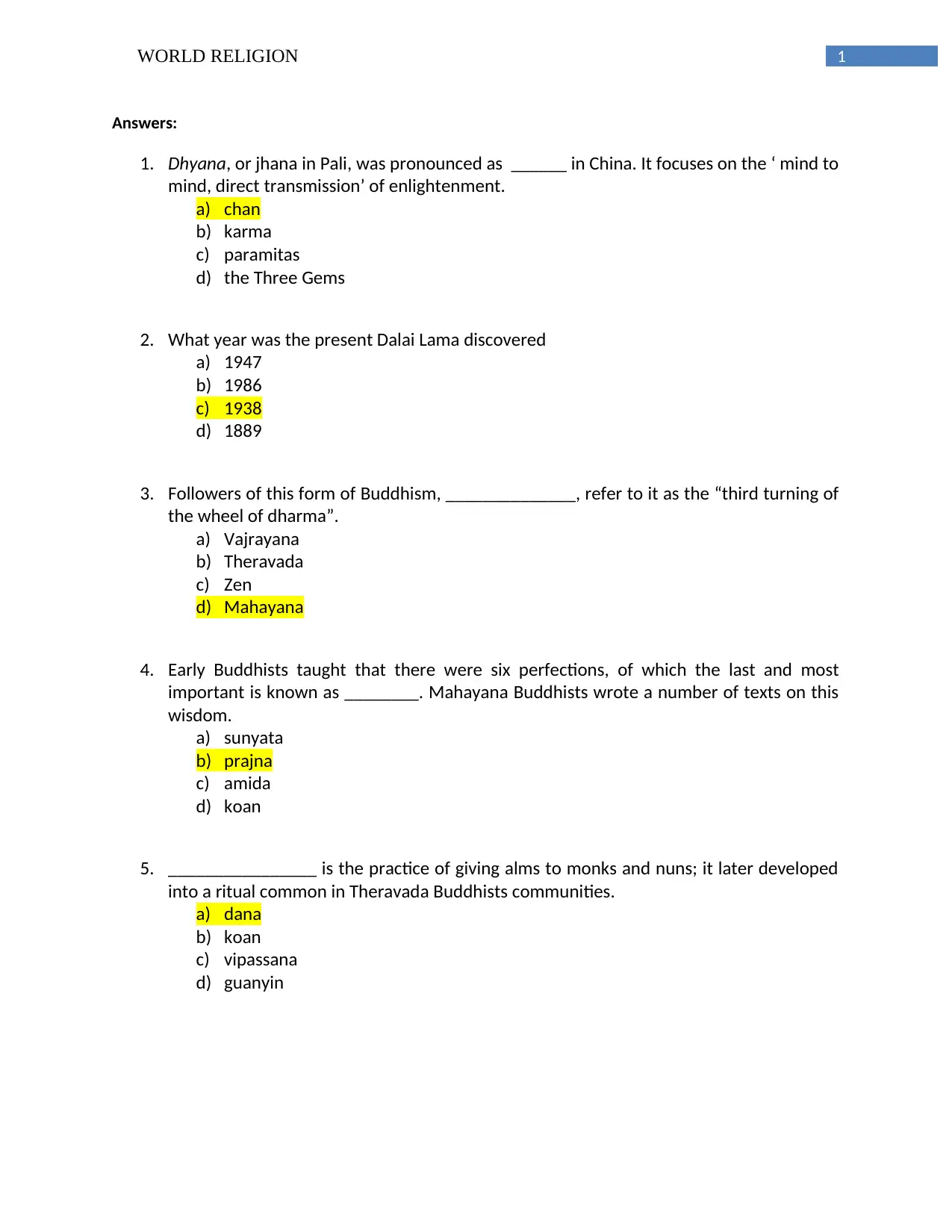
1WORLD RELIGION
Answers:
1. Dhyana, or jhana in Pali, was pronounced as ______ in China. It focuses on the ‘ mind to
mind, direct transmission’ of enlightenment.
a) chan
b) karma
c) paramitas
d) the Three Gems
2. What year was the present Dalai Lama discovered
a) 1947
b) 1986
c) 1938
d) 1889
3. Followers of this form of Buddhism, ______________, refer to it as the “third turning of
the wheel of dharma”.
a) Vajrayana
b) Theravada
c) Zen
d) Mahayana
4. Early Buddhists taught that there were six perfections, of which the last and most
important is known as ________. Mahayana Buddhists wrote a number of texts on this
wisdom.
a) sunyata
b) prajna
c) amida
d) koan
5. ________________ is the practice of giving alms to monks and nuns; it later developed
into a ritual common in Theravada Buddhists communities.
a) dana
b) koan
c) vipassana
d) guanyin
Answers:
1. Dhyana, or jhana in Pali, was pronounced as ______ in China. It focuses on the ‘ mind to
mind, direct transmission’ of enlightenment.
a) chan
b) karma
c) paramitas
d) the Three Gems
2. What year was the present Dalai Lama discovered
a) 1947
b) 1986
c) 1938
d) 1889
3. Followers of this form of Buddhism, ______________, refer to it as the “third turning of
the wheel of dharma”.
a) Vajrayana
b) Theravada
c) Zen
d) Mahayana
4. Early Buddhists taught that there were six perfections, of which the last and most
important is known as ________. Mahayana Buddhists wrote a number of texts on this
wisdom.
a) sunyata
b) prajna
c) amida
d) koan
5. ________________ is the practice of giving alms to monks and nuns; it later developed
into a ritual common in Theravada Buddhists communities.
a) dana
b) koan
c) vipassana
d) guanyin
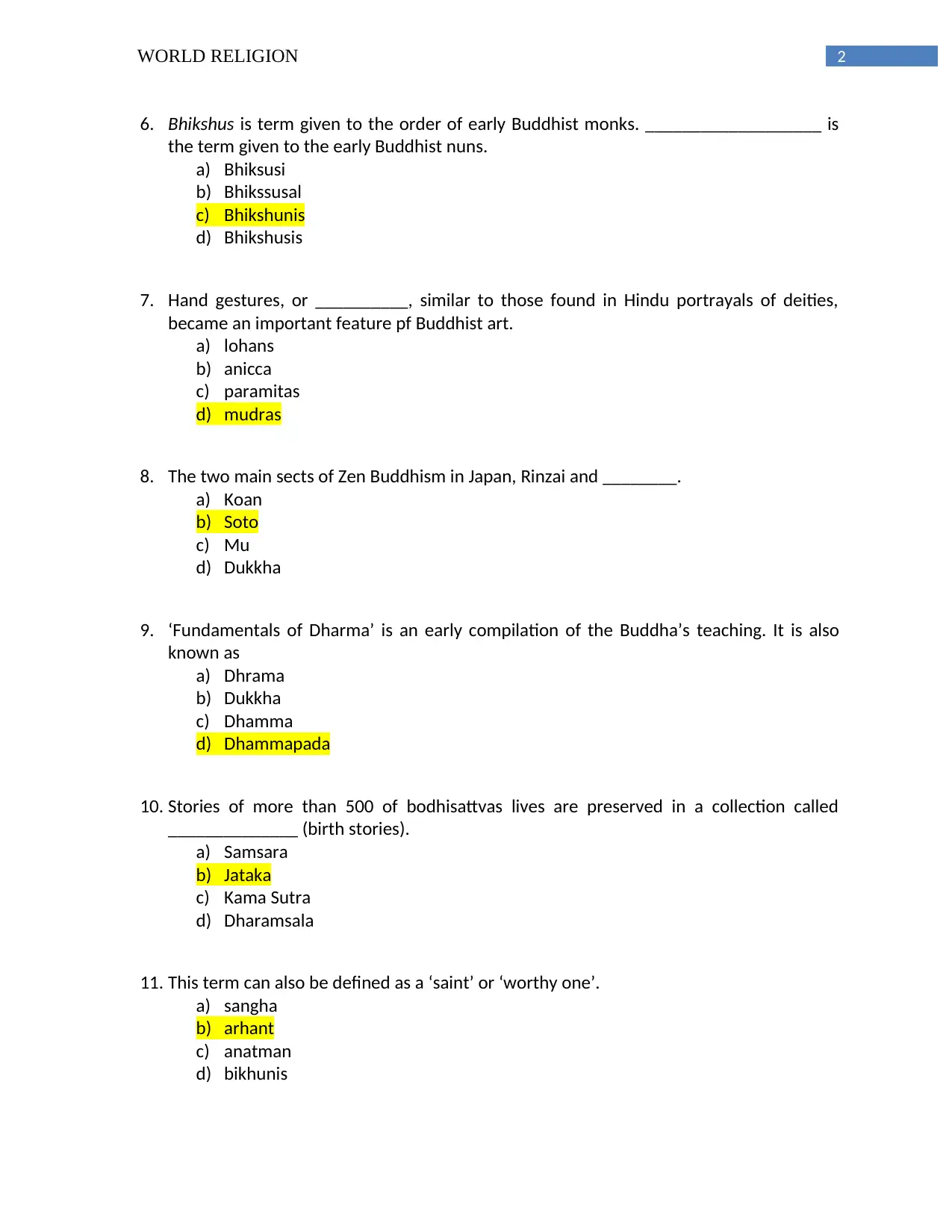
2WORLD RELIGION
6. Bhikshus is term given to the order of early Buddhist monks. ___________________ is
the term given to the early Buddhist nuns.
a) Bhiksusi
b) Bhikssusal
c) Bhikshunis
d) Bhikshusis
7. Hand gestures, or __________, similar to those found in Hindu portrayals of deities,
became an important feature pf Buddhist art.
a) lohans
b) anicca
c) paramitas
d) mudras
8. The two main sects of Zen Buddhism in Japan, Rinzai and ________.
a) Koan
b) Soto
c) Mu
d) Dukkha
9. ‘Fundamentals of Dharma’ is an early compilation of the Buddha’s teaching. It is also
known as
a) Dhrama
b) Dukkha
c) Dhamma
d) Dhammapada
10. Stories of more than 500 of bodhisattvas lives are preserved in a collection called
______________ (birth stories).
a) Samsara
b) Jataka
c) Kama Sutra
d) Dharamsala
11. This term can also be defined as a ‘saint’ or ‘worthy one’.
a) sangha
b) arhant
c) anatman
d) bikhunis
6. Bhikshus is term given to the order of early Buddhist monks. ___________________ is
the term given to the early Buddhist nuns.
a) Bhiksusi
b) Bhikssusal
c) Bhikshunis
d) Bhikshusis
7. Hand gestures, or __________, similar to those found in Hindu portrayals of deities,
became an important feature pf Buddhist art.
a) lohans
b) anicca
c) paramitas
d) mudras
8. The two main sects of Zen Buddhism in Japan, Rinzai and ________.
a) Koan
b) Soto
c) Mu
d) Dukkha
9. ‘Fundamentals of Dharma’ is an early compilation of the Buddha’s teaching. It is also
known as
a) Dhrama
b) Dukkha
c) Dhamma
d) Dhammapada
10. Stories of more than 500 of bodhisattvas lives are preserved in a collection called
______________ (birth stories).
a) Samsara
b) Jataka
c) Kama Sutra
d) Dharamsala
11. This term can also be defined as a ‘saint’ or ‘worthy one’.
a) sangha
b) arhant
c) anatman
d) bikhunis
⊘ This is a preview!⊘
Do you want full access?
Subscribe today to unlock all pages.

Trusted by 1+ million students worldwide
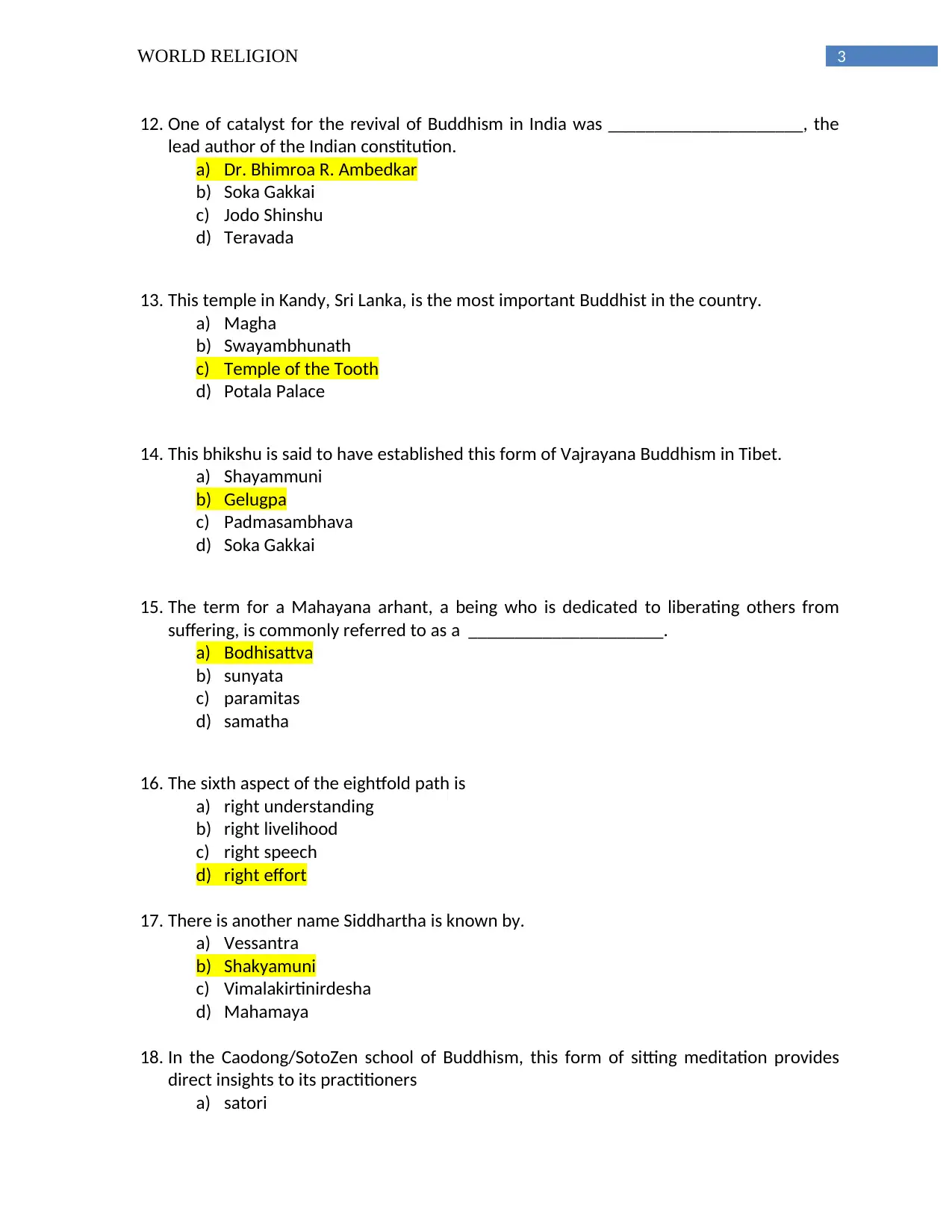
3WORLD RELIGION
12. One of catalyst for the revival of Buddhism in India was _____________________, the
lead author of the Indian constitution.
a) Dr. Bhimroa R. Ambedkar
b) Soka Gakkai
c) Jodo Shinshu
d) Teravada
13. This temple in Kandy, Sri Lanka, is the most important Buddhist in the country.
a) Magha
b) Swayambhunath
c) Temple of the Tooth
d) Potala Palace
14. This bhikshu is said to have established this form of Vajrayana Buddhism in Tibet.
a) Shayammuni
b) Gelugpa
c) Padmasambhava
d) Soka Gakkai
15. The term for a Mahayana arhant, a being who is dedicated to liberating others from
suffering, is commonly referred to as a _____________________.
a) Bodhisattva
b) sunyata
c) paramitas
d) samatha
16. The sixth aspect of the eightfold path is
a) right understanding
b) right livelihood
c) right speech
d) right effort
17. There is another name Siddhartha is known by.
a) Vessantra
b) Shakyamuni
c) Vimalakirtinirdesha
d) Mahamaya
18. In the Caodong/SotoZen school of Buddhism, this form of sitting meditation provides
direct insights to its practitioners
a) satori
12. One of catalyst for the revival of Buddhism in India was _____________________, the
lead author of the Indian constitution.
a) Dr. Bhimroa R. Ambedkar
b) Soka Gakkai
c) Jodo Shinshu
d) Teravada
13. This temple in Kandy, Sri Lanka, is the most important Buddhist in the country.
a) Magha
b) Swayambhunath
c) Temple of the Tooth
d) Potala Palace
14. This bhikshu is said to have established this form of Vajrayana Buddhism in Tibet.
a) Shayammuni
b) Gelugpa
c) Padmasambhava
d) Soka Gakkai
15. The term for a Mahayana arhant, a being who is dedicated to liberating others from
suffering, is commonly referred to as a _____________________.
a) Bodhisattva
b) sunyata
c) paramitas
d) samatha
16. The sixth aspect of the eightfold path is
a) right understanding
b) right livelihood
c) right speech
d) right effort
17. There is another name Siddhartha is known by.
a) Vessantra
b) Shakyamuni
c) Vimalakirtinirdesha
d) Mahamaya
18. In the Caodong/SotoZen school of Buddhism, this form of sitting meditation provides
direct insights to its practitioners
a) satori
Paraphrase This Document
Need a fresh take? Get an instant paraphrase of this document with our AI Paraphraser
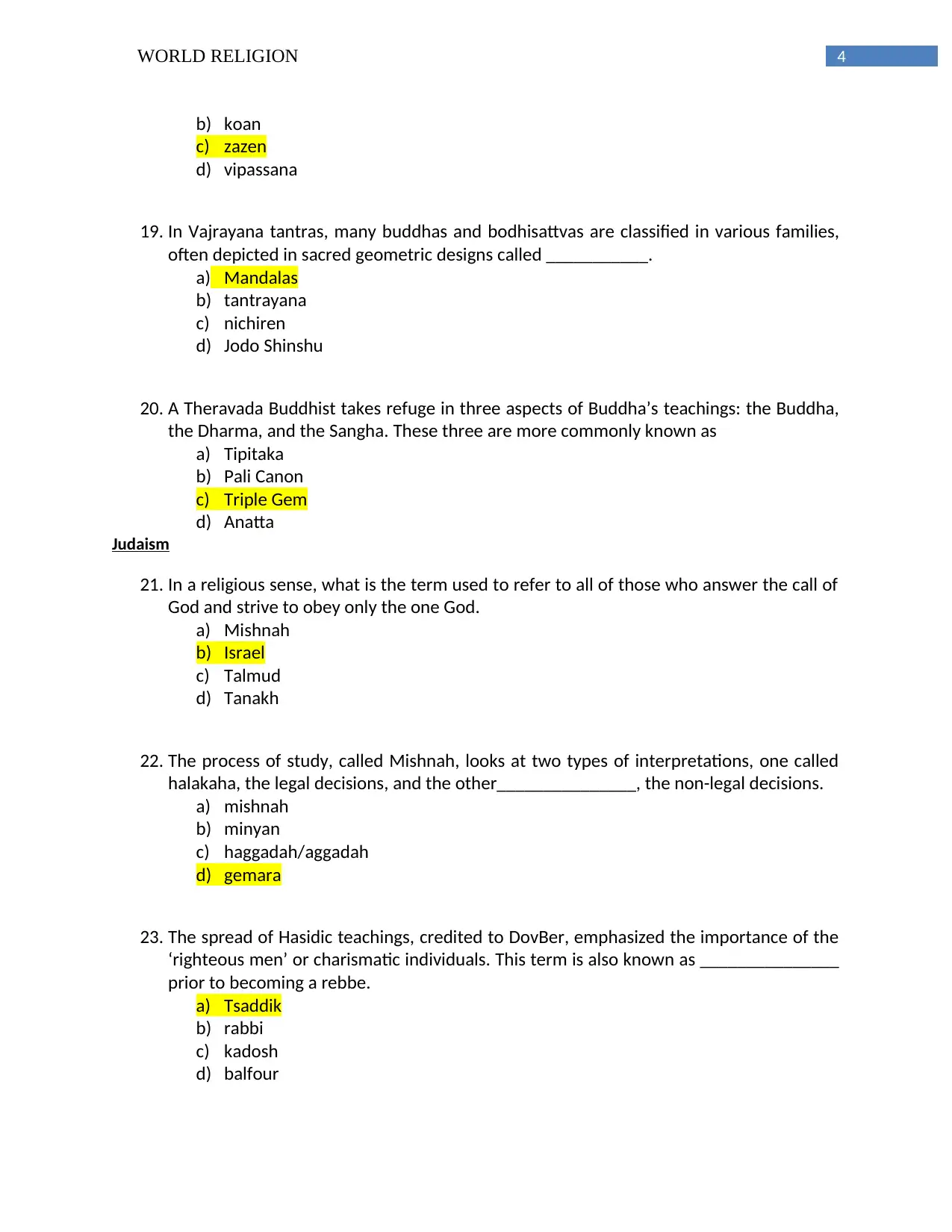
4WORLD RELIGION
b) koan
c) zazen
d) vipassana
19. In Vajrayana tantras, many buddhas and bodhisattvas are classified in various families,
often depicted in sacred geometric designs called ___________.
a) Mandalas
b) tantrayana
c) nichiren
d) Jodo Shinshu
20. A Theravada Buddhist takes refuge in three aspects of Buddha’s teachings: the Buddha,
the Dharma, and the Sangha. These three are more commonly known as
a) Tipitaka
b) Pali Canon
c) Triple Gem
d) Anatta
Judaism
21. In a religious sense, what is the term used to refer to all of those who answer the call of
God and strive to obey only the one God.
a) Mishnah
b) Israel
c) Talmud
d) Tanakh
22. The process of study, called Mishnah, looks at two types of interpretations, one called
halakaha, the legal decisions, and the other_______________, the non-legal decisions.
a) mishnah
b) minyan
c) haggadah/aggadah
d) gemara
23. The spread of Hasidic teachings, credited to DovBer, emphasized the importance of the
‘righteous men’ or charismatic individuals. This term is also known as _______________
prior to becoming a rebbe.
a) Tsaddik
b) rabbi
c) kadosh
d) balfour
b) koan
c) zazen
d) vipassana
19. In Vajrayana tantras, many buddhas and bodhisattvas are classified in various families,
often depicted in sacred geometric designs called ___________.
a) Mandalas
b) tantrayana
c) nichiren
d) Jodo Shinshu
20. A Theravada Buddhist takes refuge in three aspects of Buddha’s teachings: the Buddha,
the Dharma, and the Sangha. These three are more commonly known as
a) Tipitaka
b) Pali Canon
c) Triple Gem
d) Anatta
Judaism
21. In a religious sense, what is the term used to refer to all of those who answer the call of
God and strive to obey only the one God.
a) Mishnah
b) Israel
c) Talmud
d) Tanakh
22. The process of study, called Mishnah, looks at two types of interpretations, one called
halakaha, the legal decisions, and the other_______________, the non-legal decisions.
a) mishnah
b) minyan
c) haggadah/aggadah
d) gemara
23. The spread of Hasidic teachings, credited to DovBer, emphasized the importance of the
‘righteous men’ or charismatic individuals. This term is also known as _______________
prior to becoming a rebbe.
a) Tsaddik
b) rabbi
c) kadosh
d) balfour
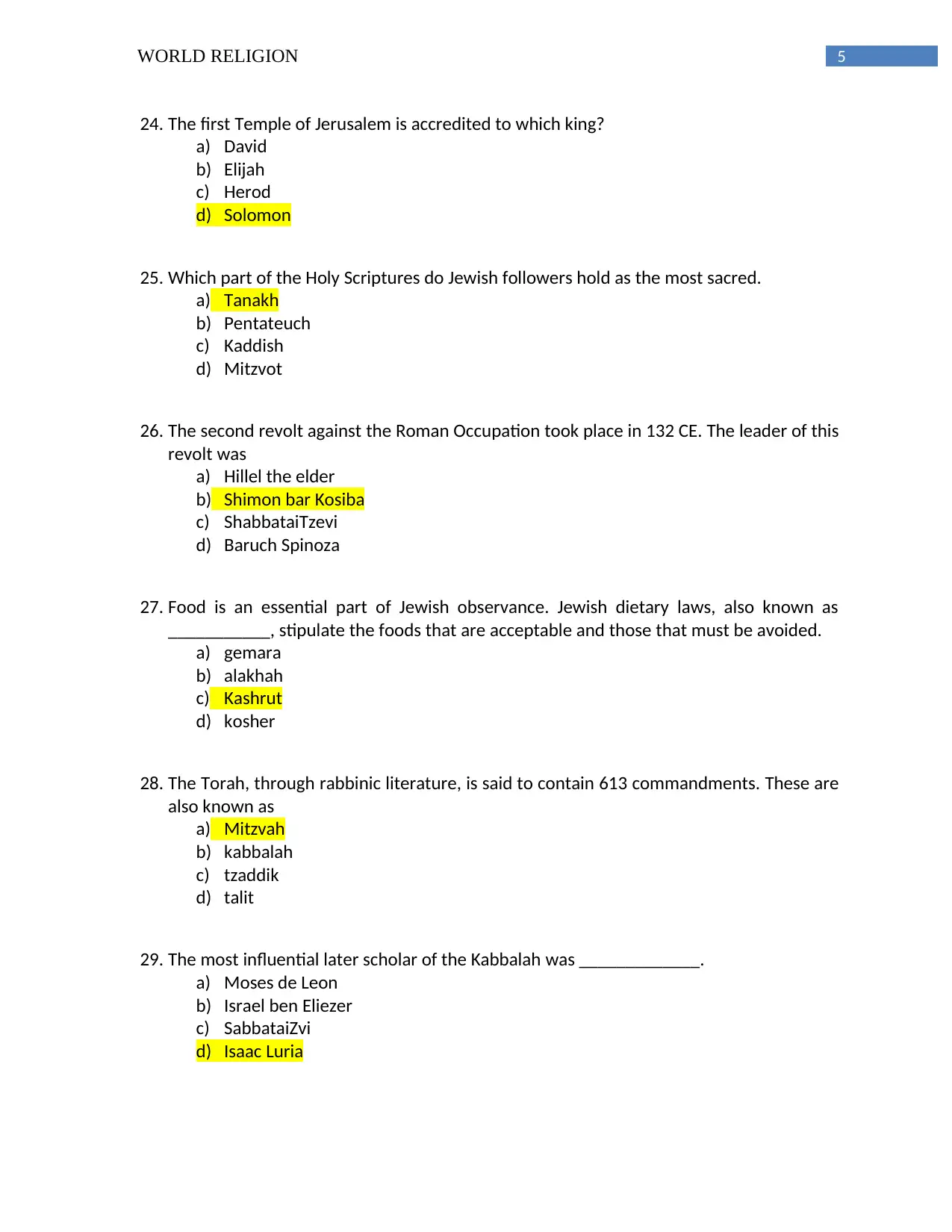
5WORLD RELIGION
24. The first Temple of Jerusalem is accredited to which king?
a) David
b) Elijah
c) Herod
d) Solomon
25. Which part of the Holy Scriptures do Jewish followers hold as the most sacred.
a) Tanakh
b) Pentateuch
c) Kaddish
d) Mitzvot
26. The second revolt against the Roman Occupation took place in 132 CE. The leader of this
revolt was
a) Hillel the elder
b) Shimon bar Kosiba
c) ShabbataiTzevi
d) Baruch Spinoza
27. Food is an essential part of Jewish observance. Jewish dietary laws, also known as
___________, stipulate the foods that are acceptable and those that must be avoided.
a) gemara
b) alakhah
c) Kashrut
d) kosher
28. The Torah, through rabbinic literature, is said to contain 613 commandments. These are
also known as
a) Mitzvah
b) kabbalah
c) tzaddik
d) talit
29. The most influential later scholar of the Kabbalah was _____________.
a) Moses de Leon
b) Israel ben Eliezer
c) SabbataiZvi
d) Isaac Luria
24. The first Temple of Jerusalem is accredited to which king?
a) David
b) Elijah
c) Herod
d) Solomon
25. Which part of the Holy Scriptures do Jewish followers hold as the most sacred.
a) Tanakh
b) Pentateuch
c) Kaddish
d) Mitzvot
26. The second revolt against the Roman Occupation took place in 132 CE. The leader of this
revolt was
a) Hillel the elder
b) Shimon bar Kosiba
c) ShabbataiTzevi
d) Baruch Spinoza
27. Food is an essential part of Jewish observance. Jewish dietary laws, also known as
___________, stipulate the foods that are acceptable and those that must be avoided.
a) gemara
b) alakhah
c) Kashrut
d) kosher
28. The Torah, through rabbinic literature, is said to contain 613 commandments. These are
also known as
a) Mitzvah
b) kabbalah
c) tzaddik
d) talit
29. The most influential later scholar of the Kabbalah was _____________.
a) Moses de Leon
b) Israel ben Eliezer
c) SabbataiZvi
d) Isaac Luria
⊘ This is a preview!⊘
Do you want full access?
Subscribe today to unlock all pages.

Trusted by 1+ million students worldwide
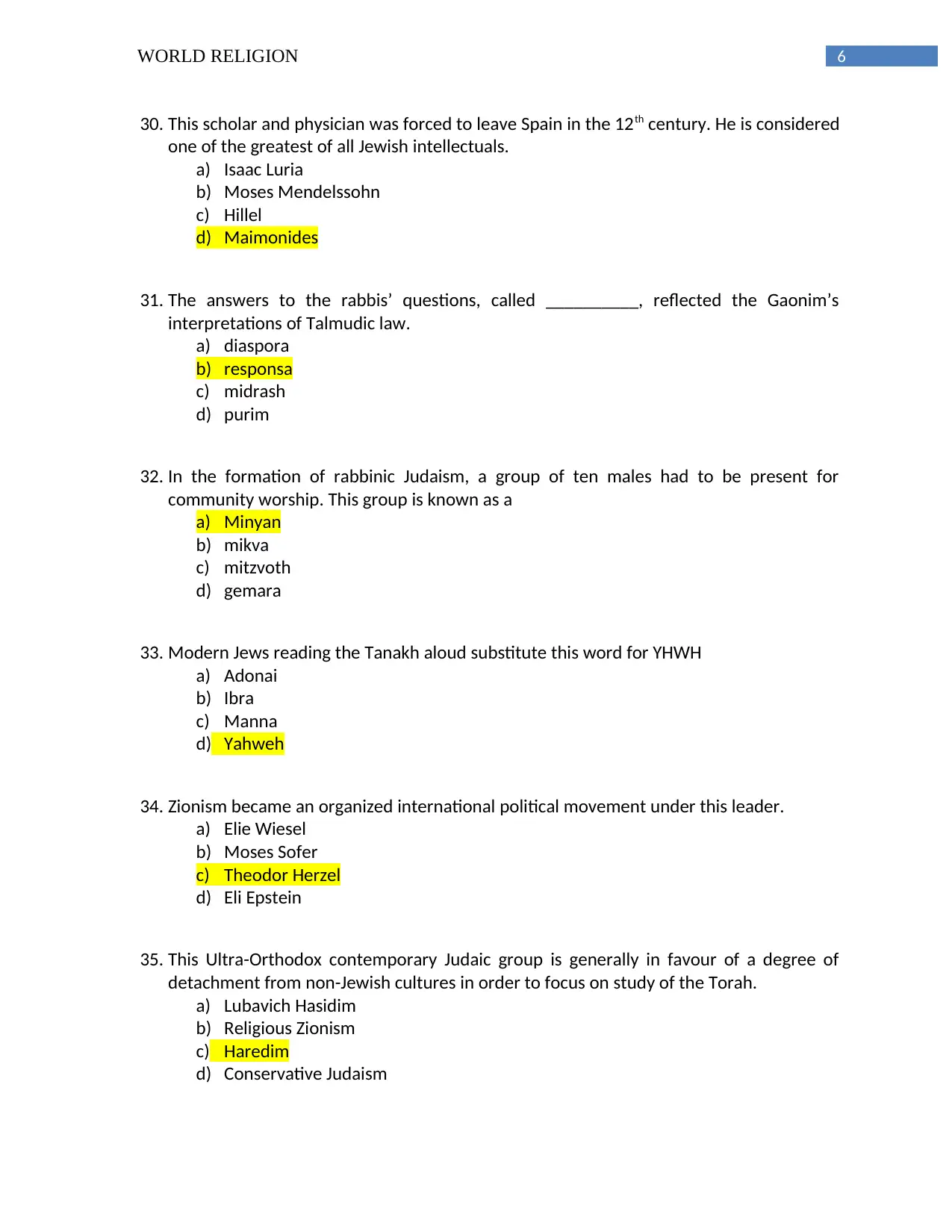
6WORLD RELIGION
30. This scholar and physician was forced to leave Spain in the 12th century. He is considered
one of the greatest of all Jewish intellectuals.
a) Isaac Luria
b) Moses Mendelssohn
c) Hillel
d) Maimonides
31. The answers to the rabbis’ questions, called __________, reflected the Gaonim’s
interpretations of Talmudic law.
a) diaspora
b) responsa
c) midrash
d) purim
32. In the formation of rabbinic Judaism, a group of ten males had to be present for
community worship. This group is known as a
a) Minyan
b) mikva
c) mitzvoth
d) gemara
33. Modern Jews reading the Tanakh aloud substitute this word for YHWH
a) Adonai
b) Ibra
c) Manna
d) Yahweh
34. Zionism became an organized international political movement under this leader.
a) Elie Wiesel
b) Moses Sofer
c) Theodor Herzel
d) Eli Epstein
35. This Ultra-Orthodox contemporary Judaic group is generally in favour of a degree of
detachment from non-Jewish cultures in order to focus on study of the Torah.
a) Lubavich Hasidim
b) Religious Zionism
c) Haredim
d) Conservative Judaism
30. This scholar and physician was forced to leave Spain in the 12th century. He is considered
one of the greatest of all Jewish intellectuals.
a) Isaac Luria
b) Moses Mendelssohn
c) Hillel
d) Maimonides
31. The answers to the rabbis’ questions, called __________, reflected the Gaonim’s
interpretations of Talmudic law.
a) diaspora
b) responsa
c) midrash
d) purim
32. In the formation of rabbinic Judaism, a group of ten males had to be present for
community worship. This group is known as a
a) Minyan
b) mikva
c) mitzvoth
d) gemara
33. Modern Jews reading the Tanakh aloud substitute this word for YHWH
a) Adonai
b) Ibra
c) Manna
d) Yahweh
34. Zionism became an organized international political movement under this leader.
a) Elie Wiesel
b) Moses Sofer
c) Theodor Herzel
d) Eli Epstein
35. This Ultra-Orthodox contemporary Judaic group is generally in favour of a degree of
detachment from non-Jewish cultures in order to focus on study of the Torah.
a) Lubavich Hasidim
b) Religious Zionism
c) Haredim
d) Conservative Judaism
Paraphrase This Document
Need a fresh take? Get an instant paraphrase of this document with our AI Paraphraser
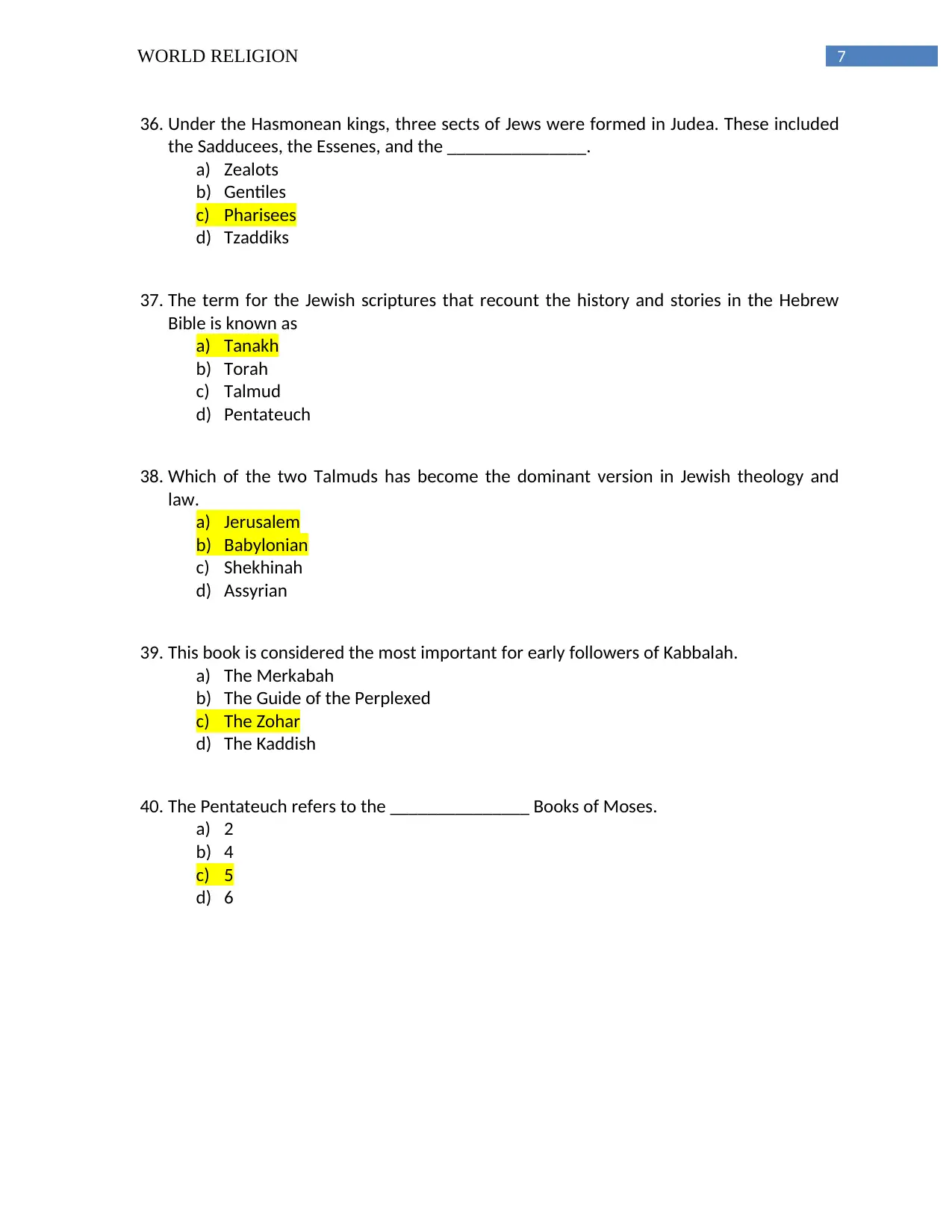
7WORLD RELIGION
36. Under the Hasmonean kings, three sects of Jews were formed in Judea. These included
the Sadducees, the Essenes, and the _______________.
a) Zealots
b) Gentiles
c) Pharisees
d) Tzaddiks
37. The term for the Jewish scriptures that recount the history and stories in the Hebrew
Bible is known as
a) Tanakh
b) Torah
c) Talmud
d) Pentateuch
38. Which of the two Talmuds has become the dominant version in Jewish theology and
law.
a) Jerusalem
b) Babylonian
c) Shekhinah
d) Assyrian
39. This book is considered the most important for early followers of Kabbalah.
a) The Merkabah
b) The Guide of the Perplexed
c) The Zohar
d) The Kaddish
40. The Pentateuch refers to the _______________ Books of Moses.
a) 2
b) 4
c) 5
d) 6
36. Under the Hasmonean kings, three sects of Jews were formed in Judea. These included
the Sadducees, the Essenes, and the _______________.
a) Zealots
b) Gentiles
c) Pharisees
d) Tzaddiks
37. The term for the Jewish scriptures that recount the history and stories in the Hebrew
Bible is known as
a) Tanakh
b) Torah
c) Talmud
d) Pentateuch
38. Which of the two Talmuds has become the dominant version in Jewish theology and
law.
a) Jerusalem
b) Babylonian
c) Shekhinah
d) Assyrian
39. This book is considered the most important for early followers of Kabbalah.
a) The Merkabah
b) The Guide of the Perplexed
c) The Zohar
d) The Kaddish
40. The Pentateuch refers to the _______________ Books of Moses.
a) 2
b) 4
c) 5
d) 6
1 out of 8
Your All-in-One AI-Powered Toolkit for Academic Success.
+13062052269
info@desklib.com
Available 24*7 on WhatsApp / Email
![[object Object]](/_next/static/media/star-bottom.7253800d.svg)
Unlock your academic potential
Copyright © 2020–2025 A2Z Services. All Rights Reserved. Developed and managed by ZUCOL.

